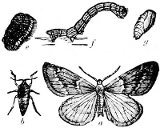Songs of Innocence and Experience Contents
The Sick Rose - Imagery, symbolism and themes
Imagery and symbolism
Rose – This literary symbol is used in three ways:
- According to medieval tradition, it represents chastity / virginity and thus was associated with young girls
- It signifies love, especially romantic passion
- It is also linked with mortality, a sign of the transience of human love and beauty, because it blooms, smells sweetly and then dies. It therefore links sex and death.
The penetration of the rose by the hidden canker worm can, therefore, be understood as the covert sex which destroys the virginity of an ‘innocent' and thus corrupts her own expression of love.
 Worm – Literally, this refers to the canker worm which attacks rosebuds. Metaphorically:
Worm – Literally, this refers to the canker worm which attacks rosebuds. Metaphorically:
- Worms are associated with death and decay, since dead bodies are said to be food for worms
- In medieval English, ‘worm' was also used to refer to a snake or serpent. It therefore may allude to the image of the snake / serpent as the seducer of Eve in the story of the Fall of humankind in Genesis chapter 3. See Big ideas from the Bible > Garden of Eden, Adam and Eve, Second Adam. Here it links sexuality and shame, just as, after the Fall, Adam and Eve ‘know they are naked' and try to hide from God
- The invisibility of the worm echoes the Christian teaching that the devil lurks unseen and is a master of disguise
- ‘Worm' also conveys phallic associations. Blake believed that when humankind ‘fell' and the sexes were separated, it had an impact on their capacity for sexual ecstasy. Capacity for ecstatic union was reduced from whole body involvement to the genitals alone.
Flies in the night – Traditionally, night is the time when demons, witches and wild beasts seek their prey and ghosts appear. It therefore suggests that this ‘worm' is active at the time when people are most prey to their fears and fantasies.
howling storm – This suggests times of ungovernable, frightening turmoil and passion that are potentially destructive.
Has found out – This may be an echo of Psalms 90:8 which refers to the exposure of ‘secret sins'
Crimson – Usually denoting passion, blood and shame, crimson and scarlet are also colours used to describe sin in the Old Testament. (See Isaiah 1:18). That the worm has ‘found out thy bed / Of crimson joy' suggests, possibly, that ideas of shame, sin and secrecy have reached to the innermost part of the person. Its capacity for ‘joy' is now infected by such life-denying emotions, bringing it death. Literally, the ‘crimson joy' may be describing the blood shed at the loss of virginity
Investigating imagery and symbolism
- What were your associations with roses and worms when you first read this poem?
- What reaction did they evoke in you?
- Having thought about some possible further associations with the images, how do you react to them now?
Themes
The effects of ‘fallenness' on repression of sexuality and other emotions
Blake believed that inhibitions lie primarily within the mind, rather than in external factors. Society makes its fears, guilt and shame into rules and laws which are then enshrined in social institutions such as the authority of parents, the Church and the State or Monarchy. Here, repression and prohibition mean that love has to be associated with secrecy and with forces that are perceived as destructive.
The effects of the Fall
A second, related theme is the effect on human relationships of fallen divided selfhood which jealously defends its pleasures, denying them to others – the love is ‘dark' and ‘secret'. One chief pleasure is exerting control over others, which can often masquerade as showing affection. This makes love devouring and destructive, as we find in this poem.
Investigating themes
- What new ideas about these two themes do you gain from this poem?
- Blake was an advocate of ‘free love'. Does this alter how you understand The Sick Rose?
- English Standard Version
- King James Version
- English Standard Version
- King James Version
The Creation; Fall of humankind and universal or original sin; Noah and the Flood; the call of Abraham (start of salvation history), followed by the stories of the other patriarchs, Isaac, Jacob and Joseph.
Big ideas: Creation; Garden of Eden, Adam and Eve; Cain and Abel; Noah and the Flood; Patriarchs
Famous stories from the Bible: Adam and Eve / Creation; Noah's Ark; Abraham
